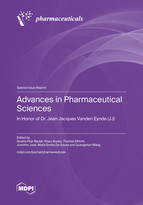Advances in Pharmaceutical Sciences: In Honor of Dr. Jean Jacques Vanden Eynde (JJ)
A special issue of Pharmaceuticals (ISSN 1424-8247).
Deadline for manuscript submissions: closed (20 May 2024) | Viewed by 39194
Special Issue Editors
Interests: neurodegenerative diseases; organic synthesis; natural products; antibiotics; antidiabetics; carbohydrate chemistry
Special Issues, Collections and Topics in MDPI journals
Interests: radiopharmaceutical drug development; radiopharmaceutical sciences; medicinal radiochemistry; radionuclide theranostics; targeted endoradiotherapy; noninvasive molecular imaging; PET; SPECT
Special Issues, Collections and Topics in MDPI journals
Interests: natural products; molecular pharmacology; cancer; drug resistance; genome-wide profiling
Special Issues, Collections and Topics in MDPI journals
Interests: autodisplay; assay development and inhibitor testing; whole cell biocatalysts for synthesis of drugs and building blocks; directed evolution of enzyme inhibitors and biocatalysts; biosensor development and diagnostic tools
Special Issues, Collections and Topics in MDPI journals
2. Laboratory of Organic and Pharmaceutical Chemistry, Faculty of Pharmacy, University of Porto, 4050-313 Porto, Portugal
Interests: medicinal chemistry; organic synthesis; heterocycles; P-glycoprotein; anticancer; antimicrobials; chiral drugs; marine natural products
Special Issues, Collections and Topics in MDPI journals
Interests: host defense antimicrobial peptides; structural bioinformatics; biomolecular NMR
Special Issues, Collections and Topics in MDPI journals
Special Issue Information
Dear Colleagues,
Dr. Jean Jacques Vanden Eynde has been the Editor-in-Chief Pharmaceuticals from 2015 to 2022. Being an organic chemist, his vision and his important contributions to the success of the journal, including fostering a friendly atmosphere between the journal and Section Editors, have indeed been highly appreciated. With enthusiasm that can be recognized by all of us, this great scientist and great Editor-in-Chief has promoted the publication of many original and review articles as well as Special Issues covering relevant topics in the scientific community, especially in the field pharmaceutical sciences, in addition to always being kind, wise, and open-minded. He introduced the Electronic Conference on Medicinal Chemistry, the ECMC, long before the pandemic, and this event is taking place for the eighth time this year, truly representing a great success. It is for us a privilege to honor him with a Special Issue dedicated to the most recent advances in pharmaceutical sciences. Original papers and reviews on topics covered by the journal Pharmaceuticals and by each of its sections are welcome.
Prof. Dr. Amélia Pilar Rauter
Prof. Dr. Klaus Kopka
Prof. Dr. Thomas Efferth
Prof. Dr. Joachim Jose
Prof. Dr. Maria Emília De Sousa
Prof. Dr. Guangshun Wang
Guest Editors
Manuscript Submission Information
Manuscripts should be submitted online at www.mdpi.com by registering and logging in to this website. Once you are registered, click here to go to the submission form. Manuscripts can be submitted until the deadline. All submissions that pass pre-check are peer-reviewed. Accepted papers will be published continuously in the journal (as soon as accepted) and will be listed together on the special issue website. Research articles, review articles as well as short communications are invited. For planned papers, a title and short abstract (about 100 words) can be sent to the Editorial Office for announcement on this website.
Submitted manuscripts should not have been published previously, nor be under consideration for publication elsewhere (except conference proceedings papers). All manuscripts are thoroughly refereed through a single-blind peer-review process. A guide for authors and other relevant information for submission of manuscripts is available on the Instructions for Authors page. Pharmaceuticals is an international peer-reviewed open access monthly journal published by MDPI.
Please visit the Instructions for Authors page before submitting a manuscript. The Article Processing Charge (APC) for publication in this open access journal is 2900 CHF (Swiss Francs). Submitted papers should be well formatted and use good English. Authors may use MDPI's English editing service prior to publication or during author revisions.
Keywords
- medicinal chemistry
- biopharmaceuticals
- natural products
- radiopharmaceutical sciences
- pharmacology and pharmaceutical technology
Benefits of Publishing in a Special Issue
- Ease of navigation: Grouping papers by topic helps scholars navigate broad scope journals more efficiently.
- Greater discoverability: Special Issues support the reach and impact of scientific research. Articles in Special Issues are more discoverable and cited more frequently.
- Expansion of research network: Special Issues facilitate connections among authors, fostering scientific collaborations.
- External promotion: Articles in Special Issues are often promoted through the journal's social media, increasing their visibility.
- Reprint: MDPI Books provides the opportunity to republish successful Special Issues in book format, both online and in print.
Further information on MDPI's Special Issue policies can be found here.












